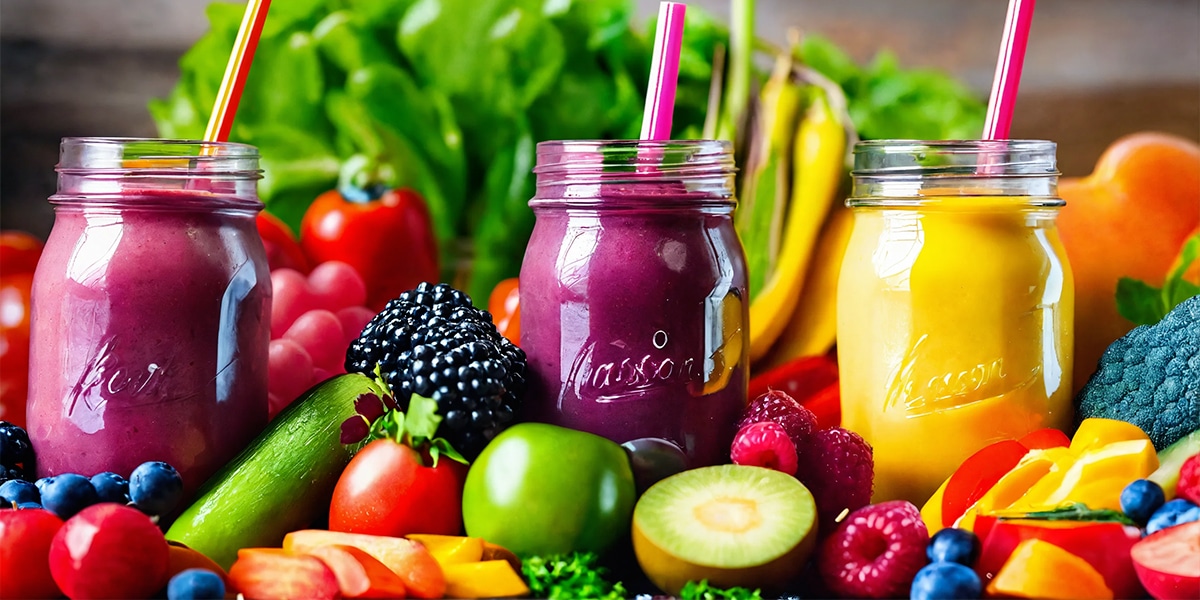In the battle against diabetes, diet plays a pivotal role in managing blood sugar levels and maintaining overall wellness. Among the myriad dietary strategies, one delicious and nutritious approach stands out: superfood smoothies. These potent blends not only tantalize the taste buds but also offer a concentrated source of vitamins, minerals, and antioxidants essential for diabetes management.
This article explores how superfood smoothies can be integrated into a diabetes wellness plan, empowering individuals to sip their way to better health.
The Power of Superfoods in Diabetes Management
Superfoods, named for their dense nutritional profiles, are exceptional allies in the fight against diabetes. Ingredients like berries, leafy greens, nuts, and seeds are rich in fiber, which helps slow down glucose absorption and reduces blood sugar spikes. Moreover, superfoods often contain compounds that improve insulin sensitivity, a key factor in managing diabetes effectively.
Crafting the Perfect Diabetic-Friendly Smoothie
Creating a smoothie that is both delicious and diabetes-friendly involves balancing flavors and nutrients while avoiding added sugars and excessive carbohydrates. Here’s how to do it:
- Start with a Low-GI Base: Opt for unsweetened almond milk, coconut water, or just plain water.
- Incorporate High-Fiber Fruits: Berries, green apples, and pears offer sweetness without a significant sugar rush.
- Add Leafy Greens: Spinach, kale, and other greens provide essential vitamins and minerals.
- Boost with Superfoods: Chia seeds, flaxseeds, and nuts can add healthy fats and protein.
- Flavor with Spices: Cinnamon, turmeric, and ginger not only add flavor but also have anti-inflammatory and blood sugar-lowering properties.
Understanding the Impact of Smoothies on Blood Sugar
Understanding the impact of smoothies on blood sugar is crucial for individuals managing diabetes or those concerned about maintaining optimal health. Smoothies, often revered for their convenience, taste, and nutritional benefits, can vary significantly in their effects on blood sugar levels based on their ingredients. Here’s a deeper look into how smoothies influence blood sugar and tips for crafting diabetes-friendly versions.
The Role of Ingredients
The key to a smoothie that supports stable blood sugar lies in the selection of ingredients. Fruits, while nutritious, contain natural sugars and carbohydrates that can impact blood sugar levels. However, combining fruits with sources of fiber, healthy fats, and proteins can slow the absorption of sugar into the bloodstream, leading to a more gradual rise in blood sugar levels.
- Fiber: Ingredients high in dietary fiber, such as leafy greens (spinach, kale), seeds (chia, flaxseeds), and nuts, can slow digestion and sugar absorption.
- Protein: Adding protein sources like Greek yogurt, protein powders, or nut butters can help stabilize blood sugar by delaying stomach emptying.
- Healthy Fats: Incorporating healthy fats from avocados or nuts can also contribute to slower digestion and absorption of sugars.
Glycemic Index and Load
Understanding the concepts of glycemic index (GI) and glycemic load (GL) can also aid in choosing smoothie ingredients that are less likely to cause rapid spikes in blood sugar. The GI measures how quickly a food raises blood sugar levels, while the GL considers the serving size, offering a more practical insight into how a food might affect blood sugar over time. Opting for low-GI and low-GL fruits and vegetables can make a smoothie more diabetes-friendly.
Smoothie Composition and Portion Control
The composition of a smoothie—how much of each ingredient is used—plays a significant role in its impact on blood sugar. Overloading a smoothie with high-GI fruits without enough fiber or protein can lead to quick rises in blood sugar. Additionally, portion control is vital; even a smoothie with balanced ingredients can negatively impact blood sugar levels if consumed in large quantities.
Impact on Blood Sugar Management
For individuals with diabetes, consuming smoothies that are carefully crafted with blood sugar management in mind can be a nutritious addition to their diet. These smoothies can provide essential vitamins, minerals, and other nutrients without significantly impacting blood sugar levels when composed and portioned correctly.
- Practical Tips for Blood Sugar-Friendly Smoothies Balance is key: Aim for a good mix of fiber, protein, and healthy fats with a moderate amount of low-GI fruits.
- Be mindful of sweeteners: Avoid adding additional sweeteners; let the natural sweetness of the fruits enhance the flavor.
| Ingredient | Glycemic Index | Key Nutrients | Benefits for Diabetes |
|---|---|---|---|
| Berries (Blueberries, Strawberries) | Low | Antioxidants, Vitamins C and K, Fiber | Improve insulin sensitivity, lower blood sugar levels |
| Chia Seeds | Low | Omega-3 Fatty Acids, Fiber | Enhance glycemic control, reduce cardiovascular risk |
| Spinach | Low | Iron, Magnesium, Vitamins A, C, and K | Low in calories, high in fiber, supports blood sugar regulation |
| Avocado | Low | Healthy Fats, Fiber, Vitamins E, K, and C | Improves lipid profile, maintains satiety, aids in weight management |
| Almond Milk (Unsweetened) | Low | Calcium, Vitamin D, Vitamin E | Low in carbs and calories, does not significantly increase blood sugar |
5 Superfood Smoothie Recipes for Diabetes Wellness
Superfood smoothie recipes for diabetes wellness incorporate nutrient-rich ingredients that not only tantalize the taste buds but also provide essential vitamins, minerals, and fibers that can have a positive impact on blood sugar levels and overall health. By carefully selecting ingredients known for their low glycemic index and high nutrient content, individuals with diabetes can enjoy delicious smoothies that contribute to stable blood sugar levels and enhanced wellness. Here are some thoughtfully crafted superfood smoothie recipes designed to support diabetes management.
1. Berry and Chia Seed Smoothie
Ingredients:
- 1 cup mixed berries (blueberries, strawberries, raspberries), fresh or frozen
- 1 tablespoon chia seeds
- 1 cup spinach leaves
- 1 cup unsweetened almond milk
- A dash of cinnamon (optional for added flavor and blood sugar control)
Benefits: Berries are low in sugar and high in antioxidants and vitamins. Chia seeds provide omega-3 fatty acids, fibers, and proteins that help in slowing down glucose absorption.
2. Green Avocado Smoothie
Ingredients:
- ½ ripe avocado
- 1 cup kale or spinach leaves
- 1 small green apple, cored and sliced
- 1 tablespoon flaxseeds
- 1 cup unsweetened almond milk or water
- A squeeze of lemon juice
Benefits: Avocado and flaxseeds are rich in healthy fats and fibers, contributing to a feeling of fullness and slower carbohydrate metabolism. Green leafy vegetables and apples add essential nutrients without significantly raising blood sugar levels.
3. Turmeric Ginger Smoothie
Ingredients:
- 1 cup unsweetened coconut milk
- ½ teaspoon ground turmeric
- ½ teaspoon ground ginger
- ½ banana
- 1 tablespoon almond butter
- A pinch of black pepper (to enhance turmeric absorption)
Benefits: Turmeric and ginger are known for their anti-inflammatory properties and potential to improve insulin sensitivity. Bananas, when used sparingly, provide potassium and fiber, while almond butter adds healthy fats and proteins.
4. Protein-Packed Hemp Smoothie
Ingredients:
- 1 cup unsweetened soy milk or hemp milk
- 2 tablespoons hemp seeds
- ½ cup frozen mixed berries
- ½ cup spinach leaves
- 1 tablespoon unsweetened cocoa powder
Benefits: Hemp seeds are a great source of plant-based protein and omega-3 fatty acids, which can aid in maintaining muscle health and preventing blood sugar spikes. Cocoa powder adds antioxidants without extra sugar.
5. Cinnamon Almond Smoothie
Ingredients:
- 1 cup unsweetened almond milk
- 1 tablespoon almond butter
- ½ teaspoon ground cinnamon
- 1 scoop low-carb protein powder (vanilla or unflavored)
- A handful of ice cubes
Benefits: Cinnamon is noted for its potential to lower blood sugar levels and improve insulin sensitivity. Almond butter and almond milk provide healthy fats and fibers, while protein powder helps in maintaining stable energy levels.
Making Superfood Smoothies Work for You
When incorporating smoothies into a diabetes wellness plan, it’s crucial to consider the overall carbohydrate content and how it fits into your daily nutritional goals. Using a blender to combine these whole, unprocessed ingredients preserves the fiber content, which is essential for slowing down the digestion of sugars and preventing spikes in blood sugar levels. For individualized advice, always consult with a healthcare provider or a dietitian who can help tailor these recipes to suit your specific health needs, preferences, and dietary restrictions.
Superfood Smoothies for Diabetes Wellness: Your FAQs Answered
What makes a smoothie 'diabetes-friendly'?
A diabetes-friendly smoothie contains low-glycemic ingredients that won’t spike blood sugar levels, along with fiber, healthy fats, and proteins to ensure balanced energy release.
Can smoothies replace a meal for someone with diabetes?
Yes, with careful planning. Ensure the smoothie has a good balance of nutrients to match that of a healthy meal.
Are fruit smoothies safe for diabetes?
In moderation, yes. Focus on low-glycemic fruits like berries and combine them with protein and healthy fats to stabilize blood sugar.
How can I sweeten my smoothies without sugar?
Use naturally sweet low-glycemic fruits like berries, or add a small amount of stevia or monk fruit sweetener.
Can I add protein powder to my smoothies?
Absolutely. Protein helps regulate blood sugar levels. Opt for unsweetened, high-quality protein powders.
Is it okay to add fats to my smoothies?
Yes. Healthy fats, like those from avocado or nuts, can slow carbohydrate absorption and improve satiety.
How often should I drink these smoothies?
Depending on your overall diet and nutritional needs, one smoothie a day can be a healthy addition to your diet.
Can these smoothies help with weight management?
Yes. When prepared with the right ingredients, they can be nutrient-dense, low in calories, and satisfying.
Do I need a special blender to make diabetes-friendly smoothies?
No special blender is required, though a high-quality blender can ensure a smoother texture.
Where can I find recipes for diabetes-friendly smoothies?
Look for recipes online on health-focused cooking blogs, in diabetes wellness books, or nutrition guides. Always consider the source’s credibility and consult with a healthcare provider or dietitian to ensure the recipes fit your specific health needs.
Citations
- Jenkins, David JA, et al. “Effect of legumes as part of a low glycemic index diet on glycemic control and cardiovascular risk factors in type 2 diabetes mellitus: a randomized controlled trial.” Archives of Internal Medicine, vol. 172, no. 21, 2012, pp. 1653-1660.
- Basu, Arpita, et al. “Blueberries decrease cardiovascular risk factors in obese men and women with metabolic syndrome.” The Journal of Nutrition, vol. 140, no. 9, 2010, pp. 1582-1587.
- Chuengsamarn, Somlak, et al. “Curcumin extract for prevention of type 2 diabetes.” Diabetes Care, vol. 35, no. 11, 2012, pp. 2121-2127.
- Panahi, Yunes, et al. “Effects of curcumin on serum cytokine concentrations in subjects with metabolic syndrome: A post-hoc analysis of a randomized controlled trial.” Biomedicine & Pharmacotherapy, vol. 82, 2016, pp. 578-582.








